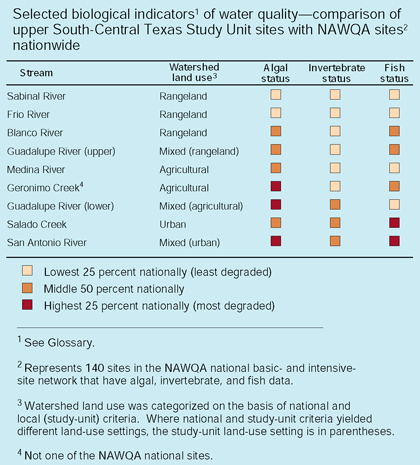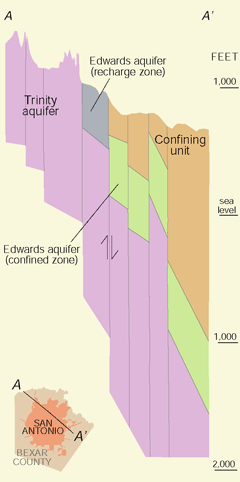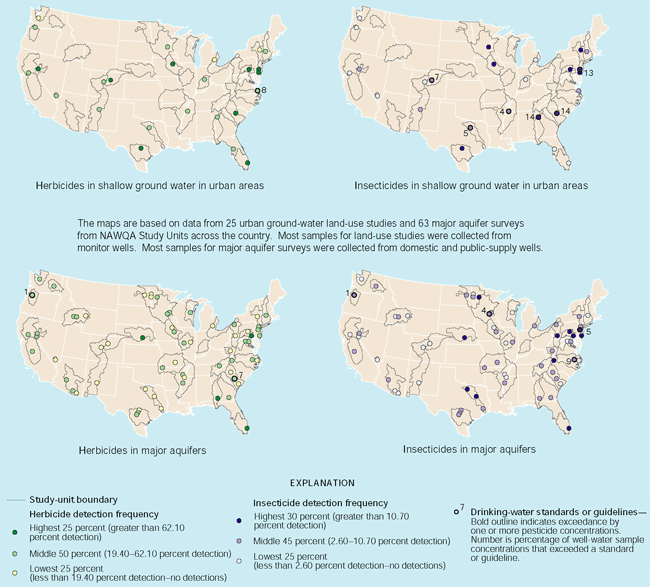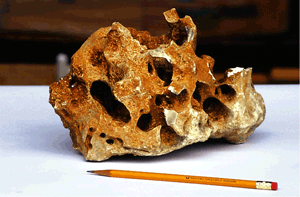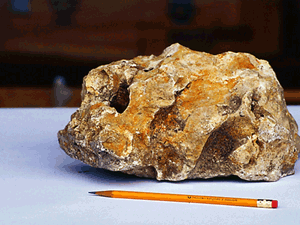MAJOR FINDINGS—Continued
Selected biological community status indicators
of stream quality nationwide show that stream quality is more likely
to be degraded in watersheds dominated by urban and agricultural
activities than those that are predominantly undeveloped. Biological
community status indicators in the Study Unit generally were consistent
with the national results. The algal status at the urban site on
the San Antonio River was the highest of all NAWQA biological sites
and is a reflection of the high nitrate and phosphorus conditions
at the site. The fish status at the site was among the highest 25
percent of NAWQA biological sites. Degraded habitat conditions (mostly
unstable sands and muds) likely contributed to the degraded condition
of algal and fish communities. These results are consistent with
the finding that the quality of water, bed sediment, and fish tissue
in the San Antonio River has been affected by proximity to development. |
Edwards Aquifer Water Quality Remains Excellent
The quality of water in the Edwards aquifer is “excellent” according to the Edwards Aquifer Authority (EAA), the State agency charged with managing, conserving, preserving, and protecting the aquifer [22]. Comprehensive analyses of water samples from 88 wells (fig. 10) (one sample per well) in the Edwards aquifer in urban, agricultural, and rangeland areas of the recharge and confined zones support that characterization. However, the fact that water samples contained detectable concentrations of pesticides and VOCs, even though the levels were well below allowable maximums in drinking water, shows that human activities can affect the aquifer.
The occurrence of contaminants in the Edwards aquifer is influenced by hydrogeology and land use. The faulted and fractured limestone of the Edwards aquifer recharge zone allows unrestricted downward movement of water containing contaminants into the ground-water-flow system, whereas the confined zone has a buffer (confining unit) between land surface and the aquifer that restricts the downward movement of water and contaminants. (See box below.) Thus, within the recharge zone, land use noticeably influences water quality; but in the confined zone, land use has much less effect.
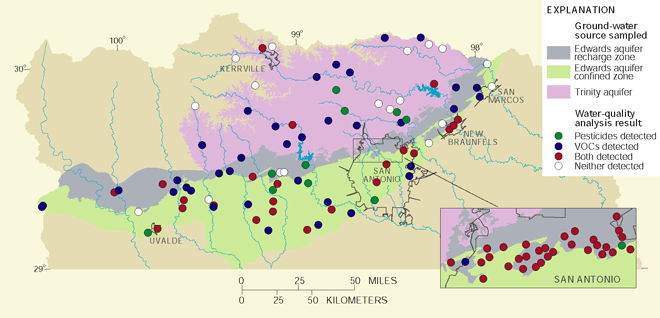 |
| Figure 10. Fifty-eight of the Edwards aquifer wells sampled were in the recharge zone, and 30 were in the confined zone. Most of the recharge-zone wells were for domestic supply or monitoring, and nearly all of the confined-zone wells were for public supply. Almost all of the urban recharge-zone samples contained both pesticides and VOCs. Most of the 31 sampled wells from the upper and middle zones of the Trinity aquifer were for domestic supply. About one-third of the Trinity aquifer samples contained no pesticides or VOCs, and only three samples contained both. |
Nutrient Concentrations Were Low
Nitrate, which dissolves readily in water, is widespread in the Edwards aquifer. It was detected in all but 1 of 88 samples. The median nitrate concentration was 1.4 mg/L in the recharge zone and 1.7 mg/L in the confined zone. Primarily public-supply wells were sampled in the confined zone.
The median concentration of 1.7 mg/L in that zone, although well below the USEPA MCL for drinking water (10 mg/L), was in the top 10 percent of median nitrate concentrations of major aquifers sampled by NAWQA nationwide. The highly permeable, faulted and fractured rocks of the recharge zone readily allow infiltration of water that contains nitrate and dissolved oxygen. Nitrate is more stable under aerobic conditions. Nitrate commonly migrates large distances from recharge areas in fractured-rock aquifers that contain considerable dissolved oxygen [26]. The median dissolved oxygen concentration in the confined zone was 6.0 mg/L.
Orthophosphate, which accounts for nearly all the dissolved phosphorus, was less prevalent than nitrate. Orthophosphate was detected in 49 of 88 well-water samples. Concentrations throughout the aquifer were low; the median concentration was 0.015 mg/L.
| Hydrogeology and Land-Use Distribution—Good for Edwards Aquifer Water Quality | ||
A fortuitous combination of hydrogeology and land-use distribution has helped to maintain the quality of water in the Edwards aquifer. Nearly all agricultural areas and much of San Antonio, the only urban area large enough to affect water quality regionally, overlie the confined zone rather than the recharge zone. In the confined zone, the Navarro-Del Rio confining unit [23], which comprises hundreds of feet of low-permeability rocks, overlies the Edwards aquifer and forms a regional barrier to vertical ground-water flow. The confining unit insulates to a large extent the part of the Edwards aquifer beneath it from the effects of land-use activities. Additionally, the streams that provide much of the recharge to the aquifer originate in and flow through what is now mostly undeveloped rangeland before reaching the recharge zone of the aquifer; thus, the streams are not carrying urban or agricultural runoff in the recharge water. Finally, the quality of Edwards aquifer water generally is enhanced by the dynamic nature of the ground-water-flow system. Since the mid-1930s, the annual flow through the system has averaged about 680,000 acre-feet [24, table 1]. One estimate of regional ground-water velocity in the aquifer is 27 feet/day [25, p. 82]. Under those conditions, contaminants tend to be diluted and have less chance of remaining stationary and accumulating than they would in a less dynamic system. |
Pesticide Concentrations Were Substantially Less Than Drinking-Water Standards and Guidelines, and Detections Were Most Frequent in Urban Recharge-Zone Wells
Seventeen of the 83 pesticides analyzed in recharge-zone samples and 18 of the 47 pesticides analyzed in confined-zone samples were detected (fig. 10); 17 of 18 were the same in both zones. At least one-half of the water samples with a pesticide detection contained two or more pesticides. The concentration of each of the 13 pesticides detected for which drinking-water standards or guidelines have been established was substantially less than the respective allowable maximum [27]. However, standards for combinations of pesticides have not been established, and very little is known about the effects of mixtures of pesticides on human health.
More pesticides were detected and frequencies of detection were greater in urban recharge-zone samples than in nonurban recharge-zone or confined-zone samples (fig. 11). Pesticide usage in urban areas likely is higher than in nonurban areas in the recharge zone. Nonurban areas in the recharge zone primarily are rangeland where usage is nonexistent or very low. Little if any direct (downward) recharge occurs in the confined zone compared with the recharge zone. Although pesticide usage in urban and agricultural areas overlying the confined zone could be greater, fewer pesticides will reach the aquifer because of the lack of direct recharge.
As was the case for stream water, the pesticide detection picture changes considerably when detection frequency is based on a common concentration of 0.05 µg/L. Among urban recharge-zone samples, only five pesticides were detected (compared with 17 without regard to a common concentration). Atrazine was the most frequently detected but only in 5.6 percent of the samples. On the basis of the common concentration, no pesticides were detected in any nonurban recharge-zone or confined-zone samples (compared with 5 and 6, respectively, without regard to a common concentration). As in stream water, the majority of pesticide detections thus represent concentrations of less than 1 part contaminant per 20 billion parts water.
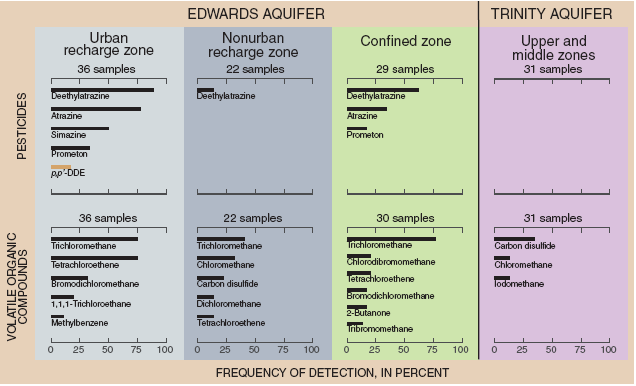 |
| Figure 11. Pesticides and VOCs in the Edwards aquifer were most frequently detected in urban recharge-zone wells. Shown are those pesticides and VOCs detected in more than 10 percent of samples. Only one insecticide, p,p'-DDE (shaded brown), a breakdown product of DDT, was detected in more than 10 percent of samples; the other pesticides shown here are herbicides. |
The Most Frequently Detected Pesticides Were the Same in Ground Water and Surface Water
Four of the 5 pesticides most frequently detected in ground water from urban recharge-zone wells— the herbicides deethylatrazine, atrazine, simazine, and prometon (fig. 11)—were the same as 4 of the 5 pesticides most frequently detected in urban streams (Salado Creek at San Antonio and San Antonio River at Elmendorf) (fig. 9). Although both sites are downstream from the recharge zone, the contaminants detected at the sites likely are typical of contaminants in urban runoff in northern San Antonio, which is in the recharge zone.
Atrazine and deethylatrazine were the most frequently detected pesticides in Edwards aquifer water and were among the top three most frequently detected pesticides in stream water. Although atrazine was detected in more than three-fourths of urban recharge-zone wells, the maximum measured concentration was about 23 times less than the drinking-water MCL, 3 µg/L. No drinking-water standard or guideline has been established for deethylatrazine.
 |
|
The frequencies of detection of herbicides and insecticides in recently recharged urban ground water in northern San Antonio (Edwards aquifer recharge zone) ranked among the highest 25 and 30 percent, respectively, of frequencies of detection in urban shallow ground water across the country. The same four pesticides—the herbicides atrazine, deethylatrazine, prometon, and simazine—were the most frequently detected in both northern San Antonio ground water and urban shallow ground water nationwide. The frequency of detection of herbicides in the Edwards aquifer was in the middle 50 percent of major aquifers nationally, and the frequency of detection of herbicides in the Trinity aquifer was in the lowest 25 percent. For insecticides, Edwards and Trinity aquifer water ranked in the middle 45 percent of frequencies of detection in major aquifers nationally. Atrazine, deethylatrazine, prometon, and p,p'-DDE were the pesticides most frequently detected in major aquifers both locally and nationally. Locally, herbicides were detected at a much greater frequency than insecticides. As the map explanation indicates, national ground-water data show the same finding. |
| The Edwards Aquifer Harbors Diverse Subterranean and Unique Spring-Dependent Aquatic Species | ||
The Edwards aquifer contains one of the most diverse subterranean biological communities in the world. At least 43 species of underground aquatic animals can be found [21], including two species of blind catfish (a predator and a forager) living several hundred feet below the surface at San Antonio [28]. The blind catfishes’ highly modified adaptations to cave life, including degree of eye reduction, are evidence that these animals are among the oldest of cave fish, having entered the ground-water system as long as 20 million years ago. Organic matter brought in from distant recharge areas would not be sufficient to support these fish and the other animals living in the deep parts of the aquifer. Rather, the aquifer is sustaining an ancient self-contained community, with hydrogen-sulfide-fixing bacteria possibly the primary food source. An additional 47 surface-water species are found only in the aquifer’s associated springs and spring runs. With this high diversity of unique, geographically restricted organisms, it is not surprising that 13 of the subterranean and spring-dwelling species—5 salamanders, 4 fish, 3 invertebrates, and 1 plant—are federally or State-listed as endangered or threatened. The spring-dwelling species are dependent on the consistent quantity and quality of flow from Comal and San Marcos Springs for their survival. |
Two Volatile Organic Compounds Were Frequently Detected at Low Concentrations
Thirty-four of 86 VOCs analyzed were detected in samples from Edwards aquifer wells. Unlike pesticides, the fewest VOCs (12) were detected in urban recharge-zone samples. Sixteen were detected in nonurban recharge-zone samples, and 27 were detected in confined-zone samples. In general, however, frequencies of detection were greatest in urban recharge-zone samples.
Trichloromethane, the most frequently detected VOC, was detected in three-fourths of the urban recharge-zone and confined-zone samples (fig. 11). Measured concentrations of trichloromethane were very low; the largest was about 80 times less than the drinking-water MCL, 100 µg/L.
Tetrachloroethene also was frequently detected. It was detected in three-fourths of the urban recharge-zone samples. The largest measured concentration of tetrachloroethene was about 12 times less than the drinking-water MCL, 5 µg/L.
When detection frequency is based on a common concentration of 0.1 µg/L, only 7 VOCs were detected—5 in urban recharge-zone samples, 3 in nonurban recharge-zone samples, and 5 in confined-zone samples. Trichloromethane remained the most frequently detected VOC, but it was detected only in about 20 percent of urban and nonurban recharge-zone samples. No other VOC was detected in more than 10 percent of recharge-zone or confined-zone samples.
MTBE, a gasoline additive of recent concern because of its potential to contaminate ground water, was detected in 2 samples, 1 from the urban recharge zone and 1 from the confined zone. Concentrations were more than 200 times less than the lifetime health advisory, 20 µg/L.
Analyses Show Very Low Concentrations of Arsenic—Detections of Lead Could Be Related to Well Construction
Arsenic, ranked first on the Agency for Toxic Substances and Disease Registry (ATSDR) and USEPA 1999 list of priority hazardous substances [29], was detected at concentrations many times less than the current (2000) drinking-water MCL of 50 mg/L (fig. 12). The median concentration of this naturally occurring element was about 1 µg/L, still less than a proposed new standard of 5 µg/L that is being considered for adoption by the USEPA in 2001.
Lead, ranked second on the ATSDR and USEPA 1999 list of priority hazardous substances, also was detected in Edwards aquifer samples. Lead concentrations ranged from 1 to 9 µg/L with a median of about 2 µg/L (fig. 12), well below the drinking-water action level for lead, 15 µg/L. Lead was detected only in previously existing domestic and public-supply wells and not in any of 30 PVC monitor wells. The monitor wells were constructed in the urban recharge zone in cooperation with the Edwards Aquifer Authority as a part of the 1996–98 assessment. This finding indicates that detections of lead could be related to metal parts of the wells or pumps.
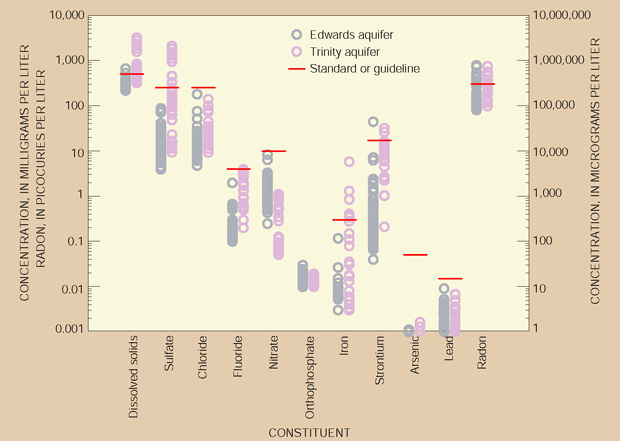 |
| Figure 12. A comparison of concentrations in samples from wells completed in the Edwards and Trinity aquifers shows that, in general, the Trinity aquifer contains higher concentrations of dissolved constituents than the Edwards aquifer. |
Radon Was Prevalent in the Edwards Aquifer, But Concentrations Were Low Compared With Other Study Units
Radon is a colorless, odorless, radioactive gas that forms naturally from uranium in rocks. Ground water in contact with some rock types—for example, light-colored volcanic rocks, granites, and dark-colored shales—can contain elevated concentrations of radon [30].
Radon was detected in 41 of 58 wells in the Edwards aquifer. (Radon was not analyzed in samples from the 30 monitor wells constructed in the urban recharge zone.) Concentrations ranged from 80 to 780 picocuries per liter (pCi/L), with a median concentration of 150 pCi/L. The 75th-percentile radon concentration in samples from wells completed in the Edwards and Trinity aquifers ranked 32 among 35 NAWQA Study Units nationwide.
Radon dissolved in water generally poses a smaller health risk than radon in indoor air, which has been linked to lung cancer in humans [31]. The USEPA has proposed an MCL for radon in drinking water of 300 pCi/L and an alternative MCL of 4,000 pCi/L, the higher level applicable when accompanied by a mitigation program to address radon risks in indoor air. About 25 percent of the sample concentrations from the Edwards aquifer exceeded the proposed MCL of 300 pCi/L.
Trinity Aquifer Water Quality Is Mostly Unaffected by Human Activities
As in the Edwards aquifer, the presence of pesticides and VOCs in ground water of the upper and middle zones of the Trinity aquifer is evidence that human activities can affect the aquifer; but as of the late 1990s, the effects of human activities were minimal. The concentrations of these contaminants were well below drinking-water standards and guidelines, and the water quality of the aquifer remains influenced primarily by the natural processes of water interacting with surrounding rock. Concentrations of some of the products of these natural processes—dissolved solids, sulfate, and iron—exceeded nonenforceable guidelines related to esthetic effects in drinking water in some samples; some concentrations of strontium and radon exceeded a lifetime health advisory (strontium) and a proposed drinking-water standard (radon).
In the largely undeveloped Hill Country, 28 of 31 mostly domestic wells sampled were in rangeland settings, 2 were in urban settings, and 1 was in an agricultural setting. Because of the predominance of rangeland, the hydrogeologic characteristics of the aquifer, and the depth to water—the median depth to water in sampled wells was 209 feet—land use probably has not been a major influence regionally on aquifer water quality.
| Although Both the Trinity and Edwards Aquifers Predominantly are Limestone, Hydrogeologic Differences Contribute to Differences in Water Quality | |||||
|
Trinity aquifer water generally is more mineralized than Edwards aquifer water (fig. 12); Edwards aquifer water tends to contain higher nitrate concentrations and more pesticides and VOCs. Some of the hydrogeologic characteristics that result in natural mineralization of Trinity aquifer water— low permeability and a sluggish flow system—tend to slow the downward movement of water that could contain contaminants. Trinity aquifer rocks are less permeable than those of the Edwards aquifer, with fewer faults and fractures to provide pathways for water movement. Water flows more slowly in the Trinity aquifer than in the Edwards aquifer, which allows more time for minerals in the Trinity aquifer rocks to dissolve. Tritium concentrations from more than one-half the Trinity aquifer water samples indicate that the water is older (at least 50 years) than most of the Edwards aquifer water. Most of the Edwards aquifer water samples had tritium concentrations that indicate recharge within the last decade. (Tritium is a radioactive isotope of hydrogen that is particularly suited for recharge studies because it enters the hydrologic cycle as part of the water molecules, and its concentrations in precipitation were increased substantially by atmospheric nuclear testing during the 1950s and early 1960s.) Sluggish flow associated with low permeability implies that the downward movement of water, and potentially the downward movement of contaminants, is much slower in the Trinity aquifer than in the Edwards aquifer recharge zone. Downward flow in the Trinity aquifer is further restricted, and diverted laterally to incised streams, by resistant beds of shale, marl, and limestone, particularly in the upper zone; similar impediments to downward flow are not present in the Edwards aquifer recharge zone.
|
|||||
Natural Water Chemistry Affects Water Quality
The 31 Trinity aquifer wells yielded hard water that generally was high (greater than 500 mg/L) in dissolved solids and rich in calcium, bicarbonate, magnesium, and sometimes sulfate. The concentrations of some common constituents (fig. 12) illustrate the chemical variability of Trinity aquifer water and, in large part, reflect the mineral composition of the rocks that compose the aquifer. Dissolved solids concentrations in 19 of 31 samples were greater than the USEPA nonenforceable drinking-water guideline of 500 mg/L. Five of 31 sulfate sample concentrations exceeded a similar nonenforceable guideline of 250 mg/L. Iron was detected in 23 of 31 samples, and concentrations exceeded the nonenforceable guideline of 0.3 mg/L in 7 of the samples. Strontium, which was detected in each of 29 samples, exceeded the USEPA lifetime health advisory level of 17 mg/L in 2 of the 29 samples.
Nutrient Concentrations Were Very Low
Nitrate was detected in 27 of the 31 well-water samples but generally at very low concentrations. The median concentration was 0.12 mg/L. Although the water that recharges the Trinity aquifer and much of the water that recharges the Edwards aquifer originate in the same region—the Edwards Plateau—the median nitrate concentration in Trinity aquifer samples was about 14 times less than that in Edwards aquifer recharge-zone samples. The difference largely is attributable to the ease with which water flows vertically to the subsurface in the Edwards aquifer recharge zone relative to that in the Trinity aquifer.
Orthophosphate was detected in 16 of the 31 well-water samples. As with nitrate, concentrations were very low. The median concentration was 0.015 mg/L.
Few Pesticides Were Detected— And Concentrations Were Very Low
Only 4 of 83 pesticides analyzed were detected in 7 of the 31 Trinity aquifer well-water samples (fig. 10). Atrazine was detected in 3 samples, prometon in 2 samples, and chlorpyrifos and diazinon in 1 sample each. Unlike Edwards aquifer and national NAWQA findings that show that pesticides commonly occur in mixtures of several compounds [13], none of the samples contained more than one pesticide.
The pesticide concentration in each sample was very low—at or near the minimum reporting level—and tens of times less than the applicable drinking-water standard or guideline. When detection frequency is based on a common concentration of 0.05 µg/L, no pesticides were detected in any Trinity aquifer water sample.
VOCs Were Detected More Frequently Than Pesticides—Also at Very Low Concentrations
Analyses of water samples from 31 Trinity aquifer wells detected 16 VOCs of the 86 analyzed. Carbon disulfide was the VOC most frequently detected (fig. 11); it was detected in 11 of 31 samples.
None of the eight VOCs detected for which drinking-water standards or guidelines have been established had concentrations near those standards or guidelines. MTBE was not detected in any sample. On the basis of a common concentration of 0.1 µg/L, the number of VOCs detected dropped from 16 to 3, which reiterates the fact that VOC concentrations were very low. The three VOCs were detected in only one sample each.
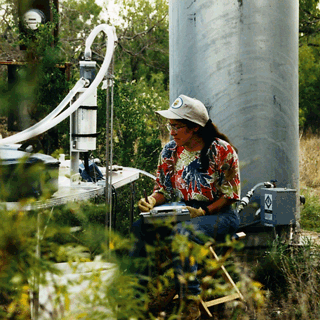 |
| NAWQA sampling protocols and procedures are detailed, exacting, and identical nationwide to reduce inconsistencies and enhance the quality of data for use in spatial and trend analysis. Here, a hydrologist is ensuring that the chemistry of the water is stable and representative of the aquifer before actual sampling of a domestic well begins. |
Arsenic and Lead Concentrations Were Low; Radon Concentrations Were Higher Than in Edwards Aquifer
As in the Edwards aquifer, arsenic and lead were detected in the Trinity aquifer at low concentrations relative to current (2000) or proposed drinking-water standards. All arsenic concentrations were less than 2 µg/L (fig. 12); the median lead concentration was 2.1 µg/L. Whether lead is actually in the aquifer or was introduced by metal parts associated with the wells is unknown.
Radon was detected in 30 of 31 Trinity aquifer water samples in concentrations throughout a range similar to that in Edwards aquifer samples (fig. 12). The median concentration, 295 pCi/L, was about twice that in Edwards aquifer samples and about the same as the USEPA-proposed MCL of 300 pCi/L. The median radon concentration of Trinity aquifer samples is greater than that of Edwards aquifer samples probably because granitic rocks north of the Hill Country, the likely source of the radon, are closer to the Trinity aquifer than to the Edwards aquifer.
| Table of Contents || Previous Section || Next Section || Glossary U.S. Geological Survey Circular 1212 Suggested citation:
|


